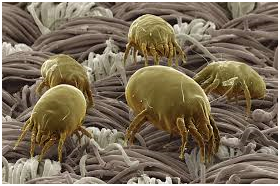Dust Mites

What Are Dust Mites?
Dust mites are the most common cause of allergy from house dust. Dust mites are hardy creatures that live and multiply easily in warm, humid places. They prefer temperatures at or above 70 degrees Fahrenheit with a relative humidity of 75 percent to 80 percent. They die when the humidity falls below 40 percent to 50 percent. They usually are not found in dry climates. Millions of dust mites can live in the bedding, mattresses, upholstered furniture, carpets or curtains of your home. They float into the air when anyone vacuums, walks on a carpet or disturbs bedding, but settle out of the air soon after the disturbance is over.
There may be many as 19,000 dust mites in one gram of dust, but usually between 100 to 500 mites live in each gram. (A gram is about the weight of a paper clip). Each mite produces about 10 to 20 waste particles per day and lives for 30 days. Egg-laying females can add 25 to 30 new mites to the population during their lifetime.
Physical characteristics of the house dust mite
1

Dust mites are Less than half a millimetre in length, this makes it hard to see with the naked eye.
2

Wingless
3

Oval-shaped body
4

Light coloured body with fine stripes
5

Life span of dust mite is around two months or so, depending on the living conditions.
What Causes Dust mite Allergy?
People who are allergic to dust mites react to proteins present within the bodies and faeces of the mite. Dust mite-allergic people; who inhale these particles frequently experience allergy symptoms.
What are the Symptoms of allergic reaction to house dust mite?
House dust mites can trigger respiratory or dermatological conditions including asthma and eczema. Symptoms can include
1
Wheezing
2
Coughing
3
Breathlessness
4
A tight feeling in the chest
5
Runny nose
6
Itchy nose
7
Itchy eyes
8
Itchy skin
9




